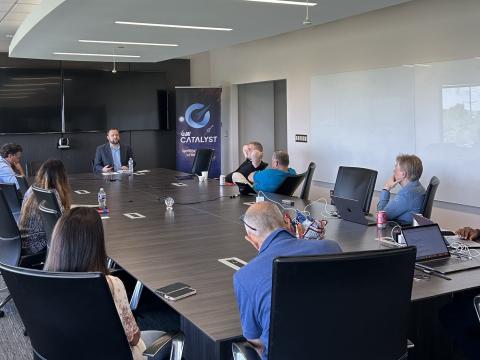Incoming: Empowering Women in Technology
"Employers, both male and female, must take a more active role in the dynamics and diversity of office teams," says Barbara Hoffman, vice president for global strategic operations at Samsung.
During the past several months, as I have visited organizations in the United States and across the world, I have heard a lot from both men and women about the need to do more to promote women in technology to leadership roles. I asked my colleague Barbara Hoffman, vice president for global strategic operations at Samsung, a former member of the Senior Executive Service and a U.S. Defense Department employee, to provide her perspectives on this issue.
“Employers, both male and female, must take a more active role in the dynamics and diversity of office teams,” Hoffman declares. “Supervisors need to be more active in including women at all career levels in meetings that involve problem-solving and collaboration. They need to support women in leadership roles while also holding them accountable for providing input in group discussions and organizational decisions.
“Employers need to support and provide programs that encourage women at all levels in technology career fields,” she continues. “All employees, both men and women, should take classes in writing, public speaking, role playing, negotiating, project management and budgeting to strengthen the office dynamics. Supervisors need to support and allow women to grow and have the same experiences and opportunities as they do for men, such as leading projects, giving speeches, running meetings and workshops.
“Throughout my career, and very typical of many government and private companies, men consistently outnumber women in any given setting, and leaders need to recognize this and encourage women and others who may be in the minority to fully participate and engage,” Hoffman says. “I believe that women tend to approach problems and challenges in nontraditional ways due to the [multiple] roles they have to fulfill both inside and outside the workplace.
“Many women have had to learn at an early stage in their careers that cooperation, inclusiveness and taking the time to develop the team will lead to better results than driving right to an answer,” she adds. “Women have the same drive—maybe even more—to succeed and an equal determination to make a difference, and many will overperform just to be viewed as equal to a man. Women typically have to state something more than once to get the same point across as a man.
“I have been very fortunate over my career to have ... worked with a few men who were wise enough to understand the diversity women bring to the table and who provided an environment that allowed women to excel, which made the organization stronger and improved mission delivery. These supervisors encouraged and even required me to take training and further my education to enhance my skills to increase my contribution to solving problems in the organization,” she concludes.
I have been guilty of some of the behaviors my colleague points out. I have spoken over the top of both men and women in team meetings. And sometimes I have viewed women as passive players when perhaps they wanted to listen to everyone’s input before sharing their own, or maybe they felt discouraged from participating. Leaders at all levels need to recognize that women, and individuals from different cultures, may need more encouragement to fully engage in team projects—and that talking the loudest doesn’t always equate to the best idea.
In my experience, many male leaders undervalue the time women will take to ensure that everyone on a team gets to be heard and often view that as passive leadership. Some male leaders will end a conversation directly or with their body language before waiting for what might be a better solution or a better addition to a developing solution.
Unfortunately, I still see too many of the traditional male and female stereotype roles being played out. Women often end up performing more of the administrative and organizational work associated with teams.
My overall experience is that women are more collaborative, more inclusive and more open to a wider set of suggestions in their approach to problems. I believe that you will get a better solution to challenges with more diverse input.
I have attended educational events on these topics within the government, but if a leader doesn’t drive change in the work climate, then the education produces little effect. I believe we have made great strides in improving the workplace for everyone, but we still have more to do. As always, feedback is welcome: signalnews@afcea.org.
Terry Halvorsen, the chief information officer (CIO) and an executive vice president with Samsung Electronics, is the former U.S. Defense Department CIO. He also has served as the Department of the Navy CIO.



Comments